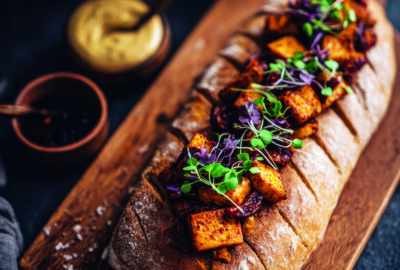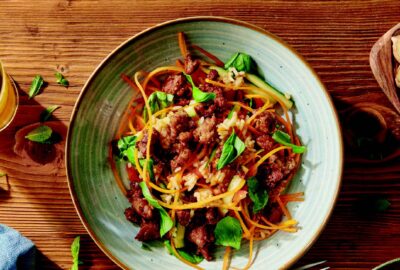As the festive season approaches, the hospitality sector buzzes with excitement and preparation. Crafting a Christmas menu that delivers a memorable experience to guests, whether in care homes, schools, restaurants, cafés, or special events, requires creativity, sensitivity to dietary needs, and a strategic approach to time and cost management. In this month’s Category Focus, we explore how to ensure your Christmas menu stands out and delights every guest, while also being efficient and cost-effective.
Embracing the Spirit of Christmas with Seasonal Ingredients
Seasonal ingredients not only enhance the authenticity of your Christmas menu but also ensure the freshest and most flavourful dishes. Think of rich, earthy root vegetables like parsnips, carrots, and beets, which are at their peak during the winter months. Incorporate these into hearty soups, roasted vegetable medleys, or as sides to main courses.
Citrus fruits, such as oranges and lemons can add a bright, zesty twist to both sweet and savoury dishes. A classic example is an orange-glazed roast duck or a refreshing lemon sorbet. Cranberries are another festive staple; use them in sauces, desserts, or even in a tangy cranberry and walnut salad on a lunchtime menu to bring a pop of colour to the table.
Creating Inclusive Menus for Diverse Dietary Needs
One of the hallmarks of a truly exceptional Christmas menu is its inclusivity. With dietary restrictions and preferences becoming more prevalent, it’s essential to offer options that cater to everyone, from vegans to those with food allergies.
For vegan guests, consider dishes like a lentil and vegetable Wellington, stuffed with a savoury mixture of lentils, mushrooms, and seasonal vegetables wrapped in flaky pastry. Another great option is a creamy butternut squash risotto, which is both comforting and satisfying. “There is a growing interest in innovative plant-based options during the holiday season for something different from the classic nut roast. Popular vegan ingredients can be incorporated to create delicious vegan roasts, hearty stews, or creative plant-based twists on traditional holiday dishes,” says Adam Bateman, Executive Chef, Pan Pacific London.
For those with allergies, ensure you have clearly labelled gluten-free, nut-free, and dairy-free options. A gluten-free stuffing made with wild rice and cranberries can be a delicious alternative to traditional bread stuffing. Additionally, offering a nut-free Christmas pudding ensures everyone can indulge in dessert without worry.
Cost-Effective Strategies
To manage costs without compromising on quality, leverage ingredients that can be used across multiple dishes. For instance, a large batch of roasted vegetables can serve as a side dish, be puréed into soups, or incorporated into salads and frittatas. Similarly, a rich vegetable stock made from peelings and trimmings can be the base for soups, sauces, and risottos. “To save money, I recommend making as many of your own dishes as possible and limiting shop-bought/readymade items. Why not make your own pigs in blankets and sauces and use some more affordable, and sometimes more flavourful, cuts like a ham hock?” suggests Adam.
Buying ingredients in bulk can also save money. For example, purchasing a whole turkey allows you to use the prime cuts for the main dish, while the bones and less desirable parts can be used to make a flavourful stock or soup.
Special Considerations for Different Settings
Each catering setting presents unique challenges and opportunities. In care homes, focus on familiar, comforting dishes that evoke nostalgia. Ensure that all food is easy to eat and digest, and consider smaller portion sizes and finger food such as pigs in blankets for residents with reduced appetites.
In schools, the priority should be on creating fun and engaging meals that appeal to children while still being nutritious. Christmas sandwiches, turkey curry packed with vegetables and inspiration from global festive menus will help inspire and engage children.
For restaurants and cafés, presentation is key. Elevate classic dishes with modern twists and sophisticated plating. A deconstructed Christmas pudding or dishes involving table theatre can make a memorable impression on diners.
Sustainability and Reducing Food Waste
As sustainability becomes increasingly important to diners, incorporating eco-friendly practices into your Christmas menu can help build your reputation. Use locally sourced, organic ingredients wherever possible to provide provenance, reduce your carbon footprint and support local farmers.
Plan your menu to minimise food waste. Repurpose leftovers creatively, such as using leftover turkey in sandwiches or salads, and turning vegetable trimmings into soups or stocks. Encourage guests to take home any uneaten food in compostable containers.
Remember, the essence of a memorable Christmas meal lies not just in the food, but in the warmth and hospitality with which it is served. Whether you’re catering for a care home, school, restaurant, café, or a special event, the goal is to create an atmosphere of joy and celebration that your guests will cherish long after the meal is over.
Time-Saving Tips
In a busy kitchen, time is of the essence. Incorporating pre-prepared elements can streamline the cooking process without sacrificing quality. Pre-made pastry dough can save time when preparing pies and tarts. Similarly, ready-to-use puff pastry can be a lifesaver for creating elegant appetisers like cheese and herb twists or mini sausage rolls.
Pre-cooked grains, such as quinoa or rice, can be quickly transformed into festive salads or sides. And for dessert, consider semi-prepared options like pre-baked tart shells that can be filled with a variety of sweet fillings, from chocolate ganache to fruit compote, with minimal effort.



